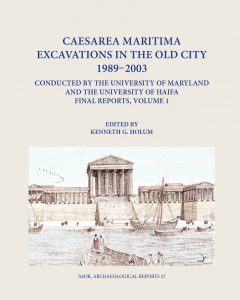
NEW ARCHAEOLOGICAL REPORTS PUBLICATION
 Caesarea Maritima Excavations in the Old City 1989-2003
Caesarea Maritima Excavations in the Old City 1989-2003
Conducted by the University of Maryland and the University of Haifa, Final Reports
Volume 1: The Temple Platform (Area TP), Neighboring Quarters (Area TPS and Z), and the Inner Harbor Quays (Area I): Hellenistic Evidence, King Herod’s Harbor Temple, Intermediate Occupation, and the Octagonal Harbor Church
edited by Kenneth G. Holum
This volume presents the results of the many years of excavation by the Combined Caesarea Expeditions, organized to explore the city and harbor of ancient Caesarea. Holum presents CCE’s original research questions, the overall stratigraphy of the site, and the team’s findings about Caesarea from the Hellenistic period to the end of antiquity in the seventh century CE. In so doing, the volume makes a significant contribution to our understanding of the transition from paganism to Christianity in Late Antiquity. It explores in depth King Herod’s pagan temple, which existed until about 400 CE, when the now Christian authorities deliberately dismantled it, removing all but its deepest foundations, and let the site lose its holiness. A century later, the authorities built a grand Octagonal Church in exactly the same spot and on the same alignment as Herod’s temple, so that it functioned as a harbor church, visible from far at sea. In the Byzantine period, Caesarea prospered and reached its largest extent. The volume presents the archaeological evidence for these developments, paying careful attention to the foundations of the temple and church, fragments of the superstructure of both monumental buildings, the Herodian and Byzantine staircases that rose directly from the harbor to the temple and church, the pottery, coins, and other evidence.
ASOR Archaeological Reports, Volume 27, Series Editor Hanan Charaf, January 2021, 472 pages, 256 b/w figures, 13 tables, 3 fold-out maps, ISBN 978-0-89757-115-9, $89.95.
Available from ISD — Distributor of Scholarly Books
www.isdistribution.com
American Society of Overseas Research
The James F. Strange Center
209 Commerce Street
Alexandria, VA 22314
E-mail: info@asor.org
© 2023 ASOR
All rights reserved.
Images licensed under a Creative Commons Attribution-NonCommercial-ShareAlike 4.0 International License
COVID-19 Update: Please consider making payments or gifts on our secure Online Portal. Please e-mail info@asor.org if you have questions or need help.
 Caesarea Maritima Excavations in the Old City 1989-2003
Caesarea Maritima Excavations in the Old City 1989-2003